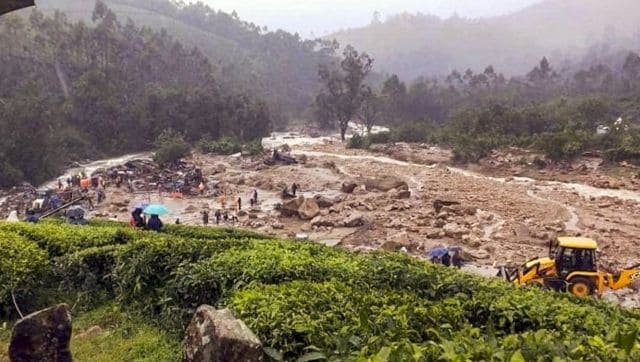Tragedy struck Kerala on Tuesday morning (July 30) after three landslides struck the hilly areas of Meppadi in Kerala’s Wayanad, killing over 80 people with hundred others feared to be trapped. Officials said that three different landslides struck the region in four hours amid heavy rain.
Shortly after news broke of the natural disaster, the Kerala State Disaster Management Authority mobilised National Disaster Response Force (NDRF) teams to the affected areas. The Indian Army has also been called in for rescue operations. Furthermore, two Air Force helicopters, a Mi-17 and an ALH (Advanced Light Helicopter), have also been put into service.
Catch all live updates from the Wayanad landslides
HERE
Mundakkai, Chooralmala, Attamala, and Noolpuzha villages are among the worst affected areas. Meanwhile, Prime Minister Narendra Modi expressed concern over the incident and said that he spoke to Kerala Chief Minister P Vijayan and assured all possible help from the Centre to the state.
“Distressed by the landslides in parts of Wayanad. My thoughts are with all those who have lost their loved ones and prayers with those injured.
“Rescue ops are currently underway to assist all those affected. Spoke to Kerala CM Shri @pinarayivijayan and also assured all possible help from the Centre in the wake of the prevailing situation there,” Modi said in a post on social media platform X.
As Kerala deals with the aftermath of the disaster, let’s understand what are landslides, what causes them and why they take place often during the rains.
What is a landslide?
A landslide is the movement of rock, earth, or debris down a sloped section of land. They can happen suddenly or more slowly over long periods of time. As per the United States Geological Survey (USGS), landslides are a type of “mass wasting,” which denotes any down-slope movement of soil and rock under the direct influence of gravity.
Additionally, the term “landslide” encompasses five modes of slope movement: falls, topples, slides, spreads, and flows. These are further subdivided by the type of geologic material (bedrock, debris, or earth). Debris flows (commonly referred to as mudflows or mudslides) and rock falls are examples of common landslide types.
The National Disaster Management Authority (NDMA) explains the occurrence of a landslide with the help of an illustration on X.
What causes landslides?
Landslides can be caused by multiple reasons. However, experts divide it into three main causes — geology, morphology, and human activity.
Geology refers to the characteristics of the material itself. The earth or rock might be weak or fractured, or different layers may have different strength and stiffness.
Morphology refers to the structure of the land. For example, slopes that lose their vegetation to fire or drought are more vulnerable to landslides. Vegetation holds soil in place, and without the root systems of trees, bushes, and other plants, the land is more likely to slide away.
Human activity, such as agriculture and construction, can increase the risk of a landslide. Irrigation, deforestation, excavation, and water leakage are some of the common activities that can help destabilise, or weaken, a slope.
Heavy rainfall can also lead to a landslide as is the case in the current one in Kerala.
Why are there more landslides during monsoon?
One of the foremost reasons for landslides is concentrated rainfall due to climate change, experts say. In the UK, an analysis carried out by the Met Office in 2012-2013 showed that a rise in heavy rainfall also saw a corresponding rise in the number of landslides.
Echoing similar observations, Partha Jyoti Das, who heads the Water, Climate and Hazard Division of the Guwahati-based environment non-profit Aaranyak told the Indian Express that when “heavy rains meet undesirable, unpragmatic, unplanned structural intervention on the fragile landscape of hills,” it can cause landslides.
Deforestation for public and private infrastructure projects leaves the soil weak and vulnerable to spate of water coming from a higher level. Whether it is an extension of a railway line, or construction of a bridge or roads, the fragile ecosystem of mountainous areas is disturbed.
An IIT Delhi study of 2020 also noted that heavy rain is destroying steep slopes with loose soil, causing landslides.
In Kerala, it’s a similar picture. Deadly landslides have become a recurring feature during the monsoon, with the Centre in 2022 saying that the southern state had recorded the highest number of major landslides in the country in the past seven years — 2,239 in Kerala.
TV Ramachandra, a noted scientist, further elaborated on the link between rainfall and landslides. Speaking to Down To Earth, he said that usually 50 to 60 per cent of rainwater is absorbed into the ground. “However, due to degradation of the landscape, the water stops percolating and with change in vegetation patterns, the soil is losing its holding capacity. This causes water to collect over the ground, loosening the soil, leading to landslides and mudslides,” he said.
With inputs from agencies
Link to article –
Wayanad landslides kill over 80: Why do landslips occur more frequently during the rains?

